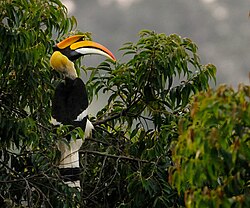Talk:Buceros bicornis
| Great hornbill | |
|---|---|

| |
| Perched on a Mesua tree at Valparai, South India | |
| Scientific classification | |
| Kingdom: | |
| Class: | |
| Order: | |
| Family: | |
| Subfamily: | |
| Genus: | |
| Binomial name | |
| Buceros bicornis Linnaeus, 1758
| |

| |
The Great Hornbill (Buceros bicornis) also known as Great Indian Hornbill or Great Pied Hornbill, is one of the larger members of the hornbill family.
Great Hornbills are found in the forests of Nepal, Republic of India, the Malay Peninsula and Sumatra, Indonesia. Their impressive size and colour have made them important in many tribal cultures and rituals. The great hornbill is long-lived, living for nearly 50 years in captivity. They are predominantly frugivorous although they are opportunists and will prey on small mammals, reptiles and birds.
